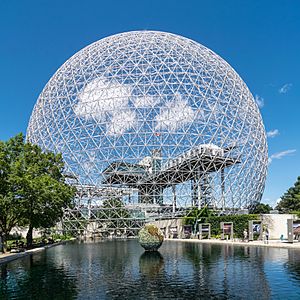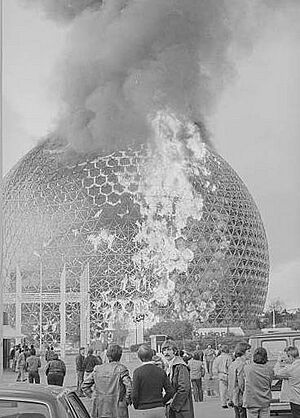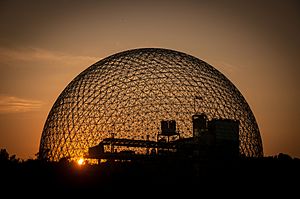Montreal Biosphere facts for kids
 |
|
| Established | 1967 |
|---|---|
| Location | 160 Tour-de-l'Isle road Montreal, Quebec H3C 4G8 |
| Type | environment museum |
| Owner | Space for Life |
| Public transit access | |
The Biosphere, also called the Montreal Biosphere, is a museum in Montreal, Quebec, Canada. It teaches people about the environment. The museum is inside a special building that used to be the United States pavilion for Expo 67. This building is located in Parc Jean-Drapeau on Saint Helen's Island. The museum's unique geodesic dome was designed by a famous architect named Buckminster Fuller.
Contents
History of the Biosphere
The Expo 67 Building
The Biosphere building was first built as the United States pavilion for Expo 67. This was a big world's fair held in Montreal. The U.S. government agency in charge of the pavilion shared its plans in June 1965. The outside of the building, which looks like a giant dome, was designed by Buckminster Fuller. Other companies helped design the inside and the exhibits. Construction started in December 1965.
Fuller had an idea for an even bigger dome. It would have had a floating sphere inside for his "World Game" project. This game would have been an interactive map of the world. It would show information about raw materials, shipping routes, and how much energy people used. Players would make choices to help the whole world. However, Fuller's ideas for the inside of the dome were not chosen.
Expo 67 opened on April 27, 1967, and closed on October 29, 1967. Visitors to the U.S. pavilion rode a very long escalator, about 41 meters (135 feet) high. It was said to be the longest escalator without support in the world. At the top, there were exhibits about NASA's space programs. Real spacecraft like the Freedom 7 and Gemini 7 were hung from the dome's steel frame.
On a lower level, the "American Spirit" exhibit showed many interesting items. These included American Indian crafts, folk art, and guitars from famous musicians. There was also a collection of dolls and almost 300 different hats. Other parts of the pavilion showed Hollywood movie items and modern American paintings. A theater showed a film about American schoolchildren playing games.
Man and His World (1968–1976)
After Expo 67 ended, the site continued as "Man and His World." This was an exhibition held every summer. The United States gave its pavilion building to the City of Montreal. It was renamed the Biosphere and opened in 1968. At first, it was an aviary (a place for birds) and an arboretum (a place for trees). It had four hanging gardens and hundreds of birds.
In 1971, the United States used the Biosphere again for an exhibit called "Visit USA." In 1972, it went back to being about nature. It even added baboons, a Japanese garden, and a children's play area. In 1973, the Biosphere became an exhibit about stopping pollution. This exhibit was sponsored by Hydro-Québec.
The 1976 Fire
On May 20, 1976, a fire badly damaged the Biosphere. The fire started because of welding work being done during repairs. It burned away the clear plastic bubble that covered the building. However, the strong steel frame of the dome remained standing.
After the fire, the city wanted to keep the Biosphere. They thought about using it as an open-air space, maybe with hanging gardens or for concerts. Plans were announced in 1977 to make it a fun area called "Man at Play," but this did not happen. By 1980, the building's future was still unknown. The city was cleaning it up, hoping to find someone to help rebuild it. The building stayed closed and unused until 1990.
Rebirth as a Museum
In August 1990, Environment Canada decided to spend $17.5 million to turn the Biosphere into an interactive museum. This new museum would focus on the water systems of the Great Lakes and Saint Lawrence River regions. The museum opened on June 6, 1995. It is made up of new buildings designed by Éric Gauthier, which are built inside the original steel frame.
In 2007, the Biosphere changed its name to become an environment museum. It now has fun, hands-on activities and exhibits. These exhibits teach visitors about important environmental issues. Topics include water, climate change, air, new green technologies, and sustainable development.
The museum also supports different causes by lighting up in special colors. For example, in April 2020, it lit up in many colors to show support during the COVID-19 pandemic. In June 2022, the museum glowed green for World Environment Day. In 2021, the Biosphere became part of Space for Life. This is a group of nature museums run by the City of Montreal.
The Pavilion Building
The museum is located inside the building that the United States built for Expo 67. The main engineer for the geodesic dome was Buckminster Fuller. The building was originally a closed structure made of steel and clear plastic panels. It was about 76 meters (249 feet) wide and 62 meters (203 feet) high. It has two layers, an inner and an outer dome, connected by a network of metal bars.
A special system of shades was used to control the temperature inside the building. The architect wanted this shading system to work like human skin, helping the building keep a steady temperature. Fuller's first idea was for the dome to have "pores" like skin. However, the shading system did not work well and was eventually turned off.
Architects from Golden Metak Productions designed the inside of the exhibition space. Visitors could explore four main areas, divided into seven levels. The building had a 37-meter (121-foot) long escalator, which was the longest ever built at that time. A small monorail called the Minirail also ran through the pavilion. In 2021, The New York Times called the dome one of the "25 Most Significant Works of Postwar Architecture."
Lasting Impact
The carbon molecule called buckminsterfullerene was named after the Biosphere's architect, R. Buckminster Fuller. This is because the molecule's shape looks like a geodesic sphere. One of its discoverers, Harold Kroto, remembered seeing the Biosphere at Expo 67.
The Biosphere's design also influenced Spaceship Earth at EPCOT Center in Walt Disney World. Disney designer John Hench took the Biosphere's three-quarter sphere idea and made it into a full sphere that looks like it's balancing on legs.
In Popular Culture
The Biosphere building has appeared in several TV shows and movies. It was used in the 1978 TV series Battlestar Galactica in an episode called "Greetings from Earth". Scenes for the movie Quintet, which is about a post-apocalyptic ice age, were also filmed there.
The Biosphere is shown in the 2003 animated TV episode "Jacob Two-Two and the Notorious Knit Knapper." In this episode, it is the secret base for a group of seniors. They plan to knit a giant tea cozy to cover the city of Montreal. The Biosphere also appeared in the final episodes of The Amazing Race: Family Edition and The Amazing Race Canada 4.
In the video game Civilization VI, the Biosphere is a "World Wonder." In the game, it makes marsh and rainforest areas more appealing. It also helps with renewable energy and tourism.
See also
 In Spanish: Biosphère de Montreal para niños
In Spanish: Biosphère de Montreal para niños
- Voice of Fire
- Biosphere
- Thin-shell structure
- List of thin shell structures



